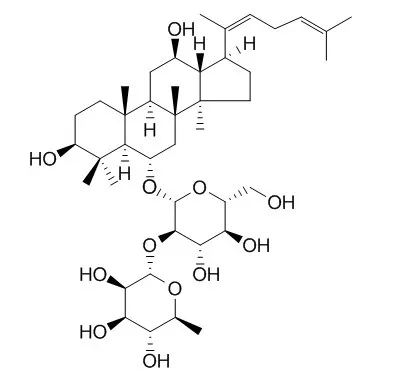| In vitro: |
| Nat Prod Res. 2013;27(24):2351-4. | | The apoptosis-inducing effect of ginsenoside F4 from steamed notoginseng on human lymphocytoma JK cells.[Pubmed: 23962295] |
METHODS AND RESULTS:
In this study, the inhibitory and apoptosis-inducing effect of Ginsenoside F4 (GF4) from steamed notoginseng was investigated by using human lymphocytoma Jurkat (JK) cell. Cell Counting Kit-8 method was then used to assess the anti-proliferative effect of GF4, and Western blotting was run to detect the expression level of two apoptosis-related proteins including Bax and the Bcl-2. The results suggested that GF4 can effectively inhibit the proliferation of the cells, and Bax expression increased gradually, but Bcl-2 expression reduced with the increase of GF4 concentration.
CONCLUSIONS:
In conclusion, GF4 has inhibitory effect on human lymphocytoma JK cell by inducing its apoptosis. The mechanism of action could be related to the mitochondrial dysfunction and the increase of Bax expression and decrease of Bcl-2 expression by GF4. | | Eur J Pharmacol. 2014 Feb 5;724:145-51. | | Ginsenosides from Korean red ginseng inhibit matrix metalloproteinase-13 expression in articular chondrocytes and prevent cartilage degradation.[Pubmed: 24384406] | Among the mammalian matrix metalloproteinases (MMPs), MMP-1, -3 and -13 are collagenases. Particularly, MMP-13 is important for the degradation of major collagens in cartilage under certain pathological conditions such as osteoarthritis.
METHODS AND RESULTS:
To establish a potential therapeutic strategy for cartilage degradation disorders, the effects of 11 ginseng saponins (ginsenosides Rb1, Rb2, Rc, Rd, Re, Rf, Rg1, Rg3, Rg5, Rk1 and F4) on MMP-13 induction were examined in a human chondrocyte cell line, SW1353. Among these, several saponins including ginsenoside Rc, Rd, Rf, Rg3 and F4 were found to inhibit MMP-13 expression in IL-1β-treated SW1353 cells at non-cytotoxic concentrations (1-50 μM). The most prominent inhibitors were ginsenosides F4 and Rg3. Ginsenoside F4 inhibited MMP-13 expression 33.5% (P<0.05), 57.9% (P<0.01) and 90.0% (P<0.01) at 10, 30 and 50 μM, respectively. Significantly, Ginsenoside F4 was found to strongly inhibit activation of p38 mitogen-activated protein kinase in signal transduction pathways (86.6 and 100.0% inhibition at 30 and 50 μM, P<0.01). The MMP-13 inhibitory effect was also supported by the finding that ginsenosides F4 and Rg3 reduced glycosaminoglycan release from IL-1α-treated rabbit joint cartilage culture to some degree. Taken together, these results indicate that several ginsenosides inhibit MMP-13 expression in IL-1β-treated chondrocytes. Ginsenoside F4 and Rg3 blocked cartilage breakdown in rabbit cartilage tissue culture.
CONCLUSIONS:
Thus, it is suggested that certain ginsenosides have therapeutic potential for preventing cartilage collagen matrix breakdown in diseased tissues such as those found in patients with arthritic disorders. |
|






 Cell. 2018 Jan 11;172(1-2):249-261.e12. doi: 10.1016/j.cell.2017.12.019.IF=36.216(2019)
Cell. 2018 Jan 11;172(1-2):249-261.e12. doi: 10.1016/j.cell.2017.12.019.IF=36.216(2019) Cell Metab. 2020 Mar 3;31(3):534-548.e5. doi: 10.1016/j.cmet.2020.01.002.IF=22.415(2019)
Cell Metab. 2020 Mar 3;31(3):534-548.e5. doi: 10.1016/j.cmet.2020.01.002.IF=22.415(2019) Mol Cell. 2017 Nov 16;68(4):673-685.e6. doi: 10.1016/j.molcel.2017.10.022.IF=14.548(2019)
Mol Cell. 2017 Nov 16;68(4):673-685.e6. doi: 10.1016/j.molcel.2017.10.022.IF=14.548(2019)